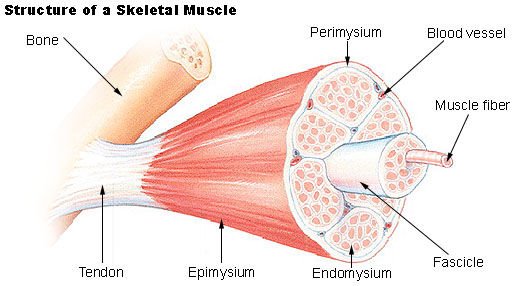Types Of Physical Fitness
|
Physical fitness is a general concept and is defined in many ways by different scientists. Physical fitness is discussed here in two major categories: health-related physical fitness and motor-performance physical fitness. Despite some overlap between these classifications, there are major differences, as described below.
Health related Physical Fitness
Health-related physical fitness is defined as fitness related to some aspect of health. This type of physical fitness is primarily influenced by an individual's exercise habits; thus, it is a dynamic state and may change. Physical characteristics that constitute health-related physical fitness include strength and endurance of skeletal muscles, joint flexibility, body composition, and cardiorespiratory endurance. All these attributes change in Strength and endurance of skeletal muscles of the trunk help maintain correct posture and prevent such problems as low back pain. Minimal levels of muscular strength and endurance are needed for routine tasks of living, such as carrying bags of groceries or picking up a young child. Individuals with very low levels of muscular strength and endurance are limited in the performance of routine tasks and have to lead a restricted life. Such limitations are perhaps only indirectly related to health, but individuals who cannot pick up and hug a grandchild or must struggle to get up from a soft chair surely have a lower quality of life than that enjoyed by their fitter peers. Flexibility, or range of motion around the joints, also ranks as an important component of health-related fitness. Lack of flexibility in the lower back and posterior thigh is thought to contribute to low back pain. Extreme lack of flexibility also has a deleterious effect on the quality of life by limiting performance. Body composition refers to the ratio between fat and lean tissue in the body. Excess body fat is clearly related to several health problems, including cardiovascular disease, type II (adult-onset) diabetes mellitus, and certain forms of cancer. Body composition is affected by diet, but exercise habits play a crucial role in preventing obesity and maintaining acceptable levels of body fat. Cardiorespiratory endurance, or aerobic fitness, is probably what most people identify as physical fitness. Aerobic fitness refers to the integrated functional capacity of the heart, lungs, vascular system, and skeletal muscles to expend energy. The basic activity that underlies this type of fitness is aerobic metabolism in the muscle cell, a process in which oxygen is combined with a fuel source (fats or carbohydrates) to release energy and produce carbon dioxide and water. The energy is used by the muscle to contract, thereby exerting force that can be used for movement. For the aerobic reaction to take place, the cardiorespiratory system (i.e., the circulatory and pulmonary systems) must constantly supply oxygen and fuel to the muscle cell and remove carbon dioxide from it. The maximal rate at which aerobic metabolism can occur is thus determined by the functional capacity of the cardiorespiratory system and is measured in the laboratory as maximal oxygen intake. As will be discussed in detail below, aerobic fitness is inversely related to the incidence of coronary heart disease and hypertension.
Motor Performance Physical Fitness
Motor Performance fitness is defined as the ability of the neuromuscular system to perform specific tasks. Test items used to assess motor-performance fitness include chin-ups, sit-ups, the 50-yard dash, the standing long jump, and the shuttle run (a timed run in which the participant dashes back and forth between two points). The primary physical characteristics measured by these tests are the strength and endurance of the skeletal muscles and the speed or power of the legs. These traits are important for success in many types of athletics. Muscular strength and endurance are also related to some aspects of health, as stated above. There is disagreement among experts about the relative importance of health-related and motor-performance physical fitness. While both types of fitness are obviously desirable, their relative values should be determined by an individual's personal fitness objectives. If success in athletic events is of primary importance, motor-performance fitness should be emphasized. If concern about health is paramount, health-related fitness should be the focus. Different types of fitness may be important not only to different individuals but also to the same individual at different times. The 16-year-old competing on a school athletic team is likely to focus on motor performance. The typical middle-aged individual is not as likely to be concerned about athletic success, emphasizing instead health and appearance. One further point should be made: to a great extent, motor-performance physical fitness is determined by genetic potential. The person who can run fast at 10 years of age will be fast at age 17; although training may enhance racing performance, it will not appreciably change the individual's genetically determined running speed. On the other hand, characteristics of health-related physical fitness, while also partly determined by inheritance, are much more profoundly influenced by exercise habits.
Weight training
System of physical conditioning using such weights as barbells and dumbbells and other devices, including Nautilus machines. It is a training system rather than a competitive sport such as weight lifting or power lifting. Weight training is used both for physical rehabilitation and for athletic and general conditioning. Athletes use it to improve their performance by increasing strength and endurance. It is used extensively by track-and-field athletes, swimmers, football players, and soccer players, as well as by other sportsmen for whom basic strength is important to their training program. Weight training also is used to promote general physical fitness and conditioning and to develop the musculature for physique and body-building contests. In rehabilitation after an illness, injury, or long confinement, weight training is commonly referred to as progressive resistance exercise, and it is usually undertaken at the direction of a physician. Generally, the type and number of exercises vary with the practitioner's objectives, age, sex, weight, and experience. Because of this, weight training is best performed under the direction of an experienced coach or physical therapis
Jogging Form of running at an easy pace, particularly popular from the 1960s in the United States. There, an estimated 7,000,000 to 10,000,000 joggers sought fitness, weight loss, grace, physical fulfillment, and relief from stress by jogging. Joggers expend from 10 to 13 calories per minute in this exercise (compared with approximately 7 to 9 calories per minute for tennis). The popularity of this activity was given substantial impetus by the publication of the book Jogging (1967) by Bill Bowerman, a University of Oregon track coach, and W.E. Harris, a heart specialist. The practice of jogging originated in New Zealand when an Olympic track coach, one Dr. Lydiard, suggested it as a conditioning activity for retired Olympic runners; Bowerman observed the activity there and was impressed. Jogging has been endorsed by many medical authorities for its value as a heart exercise and for general physical conditioning, usually to be practiced on alternate days. Other medical authorities, however, warn that fallen arches, shin splints, sweat miliaria, strained Achilles tendons, bruised heels, and knee and back ailments can result from jogging—usually done on hard surfaces with the feet striking the ground from 600 to 750 times per mile. Warm-up exercises before jogging, properly designed shoes, loose clothing, proper jogging technique, and general good health—as well as sensible objectives—are necessary for safe pursuit of the activity. The U.S. National Jogging Association was formed in 1968 to promote the pastime. |
 response to appropriate physical conditioning programs, and all are related to health.
response to appropriate physical conditioning programs, and all are related to health.